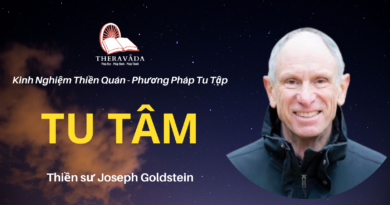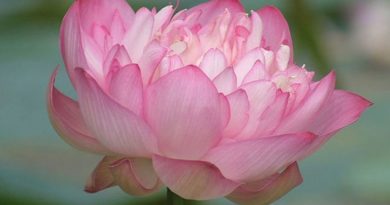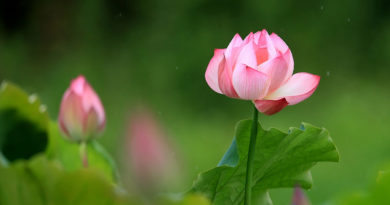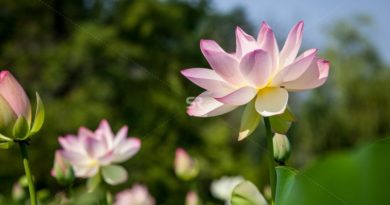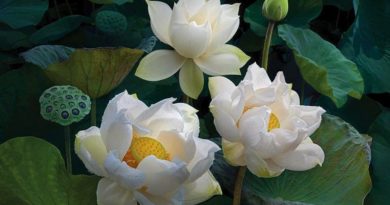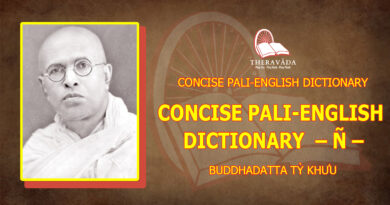JHANA NOT BY THE NUMBERS
JHANA NOT BY THE NUMBERS
When I first went to study with my teacher, Ajaan Fuang, he handed me a small booklet of meditation instructions and sent me up the hill behind the monastery to meditate. The booklet — written by his teacher, Ajaan Lee — began with a breath meditation technique and concluded with a section showing how the technique was used to induce the first four levels of jhana.
In the following years, I saw Ajaan Fuang hand the same booklet to each of his new students, lay and ordained. Yet despite the booklet’s detailed descriptions of jhana, he himself rarely mentioned the word jhana in his conversations, and never indicated to any of his students that they had reached a particular level of jhana in their practice. When a student told him of a recurring meditative experience, he liked to discuss not what it was, but what to do with it: what to focus on, what to drop, what to change, what to maintain the same. Then he’d teach the student how to experiment with it — to make it even more stable and restful — and how to judge the results of their experiments. If his students wanted to measure their progress against the descriptions of jhana in the booklet, that was their business and none of his. He never said this in so many words, but given the way he taught, the implicit message was clear.
As were the implicit reasons for his attitude. He had told me once about his own experiences as a young meditator: “Back in those days you didn’t have books explaining everything the way we do now. When I first studied with Ajaan Lee, he told me to bring my mind down. So I focused on getting it down, down, down, but the more I brought it down, the heavily and duller it got. I thought, ‘This can’t be right.’ So I turned around and focused on bringing it up, up, up, until I found a balance and could figure out what he was talking about.” This incident was one of many that taught him some important lessons: that you have to test things for yourself, to see where the instructions had to be taken literally and where they had to be taken figuratively; that you had to judge for yourself how well you were doing; and that you had to be ingenious, experimenting and taking risks to find to ways to deal with problems as they arose.
So as a teacher, he tried to instill in his students these qualities of self-reliance, ingenuity, and a willingness to take risks and test things for themselves. He did that not only by talking about these qualities, but also by forcing you into situations where you’d have to develop them. Had he always been there to confirm for you that, “Yes, you’ve reached the third jhana,” or, “No, that’s only the second jhana,” he would have short-circuited the qualities he was trying to instill. He, rather than your own powers of observation, would have been the authority on what was going on in your mind; and you would have been absolved of any responsibility for correctly evaluating what you had experienced. At the same time, he would have been feeding your childish desire to please or impress him, and undermining your ability to deal with the task at hand, which was how to develop your own powers of sensitivity to put an end to suffering and stress. As he once told me, “If I have to explain everything, you’ll get used to having things handed to you on a platter. And then what will you do when problems come up in your meditation and you don’t have any experience in figuring things out on your own?”
So, studying with him, I had to learn to take risks in the midst of uncertainties. If something interesting came up in the practice, I’d have to stick with it, observing it over time, before reaching any conclusions about it. Even then, I learned, the labels I applied to my experiences couldn’t be chiseled in rock. They had to be more like post-it notes: convenient markers for my own reference that I might have to peel off and stick elsewhere as I became more familiar with the territory of my mind. This proved to be a valuable lesson that applied to all areas of my practice.
Still, Ajaan Fuang didn’t leave me to reinvent the dharma wheel totally on my own. Experience had shown him that some approaches to concentration worked better than others for putting the mind in a position where it could exercise its ingenuity and accurately judge the results of its experiments, and he was very explicit in recommending those approaches. Among the points he emphasized were these:
Strong concentration is absolutely necessary for liberating insight. “Without a firm basis in concentration,” he often said, “insight is just concepts.” To see clearly the connections between stress and its causes, the mind has to be very steady and still. And to stay still, it requires the strong sense of well being that only strong concentration can provide.
To gain insight into a state of concentration, you have to stick with it for a long time. If you push impatiently from one level of concentration to the next, or if you try to analyze a new state of concentration too quickly after you’ve attained it, you never give it the chance to show its full potential and you don’t give yourself the chance to familiarize yourself with it. So you have to keep working at it as a skill, something you can tap into in all situations. This enables you to see it from a variety of perspectives and to test it over time, to see if it really is as totally blissful, empty, and effortless as it may have seemed on first sight.
The best state of concentration for the sake of developing all-around insight is one that encompasses a whole-body awareness. There were two exceptions to Ajaan Fuang’s usual practice of not identifying the state you had attained in your practice, and both involved states of wrong concentration. The first was the state that comes when the breath gets so comfortable that your focus drifts from the breath to the sense of comfort itself, your mindfulness begins to blur, and your sense of the body and your surroundings gets lost in a pleasant haze. When you emerge, you find it hard to identify where exactly you were focused. Ajaan Fuang called this moha-samadhi, or delusion-concentration.
The second state was one I happened to hit one night when my concentration was extremely one-pointed, and so refined that it refused settle on or label even the most fleeting mental objects. I dropped into a state in which I lost all sense of the body, of any internal/external sounds, or of any thoughts or perceptions at all — although there was just enough tiny awareness to let me know, when I emerged, that I hadn’t been asleep. I found that I could stay there for many hours, and yet time would pass very quickly. Two hours would seem like two minutes. I could also “program” myself to come out at a particular time.
After hitting this state several nights in a row, I told Ajaan Fuang about it, and his first question was, “Do you like it?” My answer was “No,” because I felt a little groggy the first time I came out. “Good,” he said. “As long as you don’t like it, you’re safe. Some people really like it and think it’s nibbana or cessation. Actually, it’s the state of non-perception (asaññi-bhava). It’s not even right concentration, because there’s no way you can investigate anything in there to gain any sort of discernment. But it does have other uses.” He then told me of the time he had undergone kidney surgery and, not trusting the anesthesiologist, had put himself in that state for the duration of the operation.
In both these states of wrong concentration, the limited range of awareness was what made them wrong. If whole areas of your awareness are blocked off, how can you gain all-around insight? And as I’ve noticed in years since, people adept at blotting out large areas of awareness through powerful one-pointedness also tend to be psychologically adept at dissociation and denial. This is why Ajaan Fuang, following Ajaan Lee, taught a form of breath meditation that aimed at an all-around awareness of the breath energy throughout the body, playing with it to gain a sense of ease, and then calming it so that it wouldn’t interfere with a clear vision of the subtle movements of the mind. This all-around awareness helped to eliminate the blind spots where ignorance likes to lurk.
An ideal state of concentration for giving rise to insight is one that you can analyze in terms of stress and the absence of stress even while you’re in it. Once your mind was firmly established in a state of concentration, Ajaan Fuang would recommend “lifting” it from its object, but not so far that the concentration was destroyed. From that perspective, you could evaluate what levels of stress were still present in the concentration and let them go. In the initial stages, this usually involved evaluating how you were relating to the breath, and detecting more subtle levels of breath energy in the body that would provide a basis for deeper levels of stillness. Once the breath was perfectly still, and the sense of the body started dissolving into a formless mist, this process would involve detecting the perceptions of “space,” “knowing,” “oneness,” etc., that would appear in place of the body and could be peeled away like the layers of an onion in the mind. In either case, the basic pattern was the same: detecting the level of perception or mental fabrication that was causing the unnecessary stress, and dropping it for a more subtle level of perception or fabrication until there was nothing left to drop.
*
This was why, as long as your awareness was still and alert all-around, it didn’t matter whether you were in the first or the fourteenth jhana, for the way you treated your state of concentration was always the same. By directing your attention to issues of stress and its absence, he was pointing you to terms by which to evaluate your state of mind for yourself, without having to ask any outside authority. And, as it turns out, the terms you can evaluate for yourself — stress, its cause, its cessation, and the path to its cessation — are the issues that define the four noble truths: the right view that the Buddha says can lead to total liberation.
-ooOoo-


